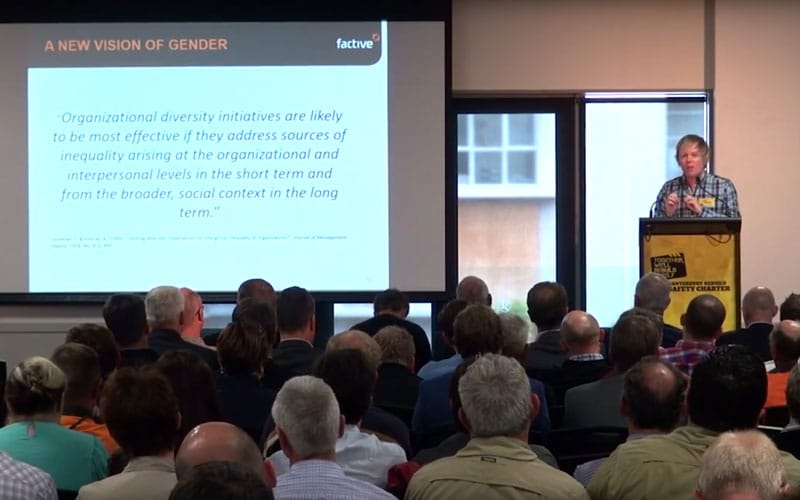8 December 2014: Safety and Gender in Construction

8 December 2014: Safety and Gender in Construction
‘INSPIRATIONAL’ – SAFETY AND GENDER IN CONSTRUCTION
“Dean’s presentation was riveting. He challenges our beliefs about ourselves and how our gender affects our attitude to safety.” Graham Burke, President of the Specialist Trade Contractor’s Federation.
Sponsored by WorkSafe New Zealand and CERA
More than 200 signatories attended the December 2014 quarterly event on Safety and Gender in Construction in Christchurch on 8 December 2014. Leading researcher in gender in male-dominated industries, Dr Dean Laplonge, from Factive in Australia is a leading researcher in gender in male-dominated industries and was the keynote speaker. We also welcomed another 20 signatories to the Charter.
A summary of Dean’s presentation is below. You can also watch his presentation on our YouTube channel .
Key points
In the research and work on gender, “gender” has long been understood as something more complex than simply men versus women. Unfortunately, in heavy industries (like mining, oil & gas, and construction) “gender” is still seen as something that only affects women.
We need to think of gender as relational, organisational, contextual, historical, cultural, and oppositional. All these newer ways of thinking about gender allow us to explore gender as practices, ways of behaving, attitudes, and expectations. This is how we truly come to understand “gender diversity” and what it means in our workplaces.
We also need to include ideas about men and masculinity in our work on gender.
When we think of gender in these newer ways, we can start to understand how gender affects safety, and vice versa.
Understandings of gender affect safety in the workplace; this is shown in the research. In male-dominated industries, there is a higher risk that people will engage in at-risk behaviours because of the demand that they act out gender in particular ways.
How to respond
There are a range of different ways we can work with gender to improve safety outcomes. These include:
- Developing skills in understanding gendered behaviours for safety professionals
- Raising awareness of the link between safety and gender for leaders, safety professionals, and human resources personnel
- Working with small teams to explore how gender is practised within the team and how the team’s practices of gender might be affecting the safety of personnel
- Carrying out an audit of the safety management system to identify where gender sits within this system and how the system might be promoting at-risk gendered behaviours
Key readings
If you are interested in learning more about the link between gender and safety in the workplace, you can take a look at the following articles:
- “Guidelines for gender and safety” in So you think you’re tough: Getting serious about gender in mining.
- “Occupations of Masculinity” in the Journal of Occupational Science.
- “Telling tales of safety to men in mining” in the Australian and New Zealand Journal of Health, Safety and Environment.
- “Doing safer masculinities” in m/c Journal.
- “Gendering practices, practicing gender at work” in Gender and Society.
- “Toughness in the workplace” by The Department of Mines and Petroleum (WA).
Factive also offers a distance learning course on Gender and Safety in the Workplace.
Contact
If you have any questions about the link between gender and safety in the workplace, please contact Dr. Dean Laplonge at dean@factive.com.au.
